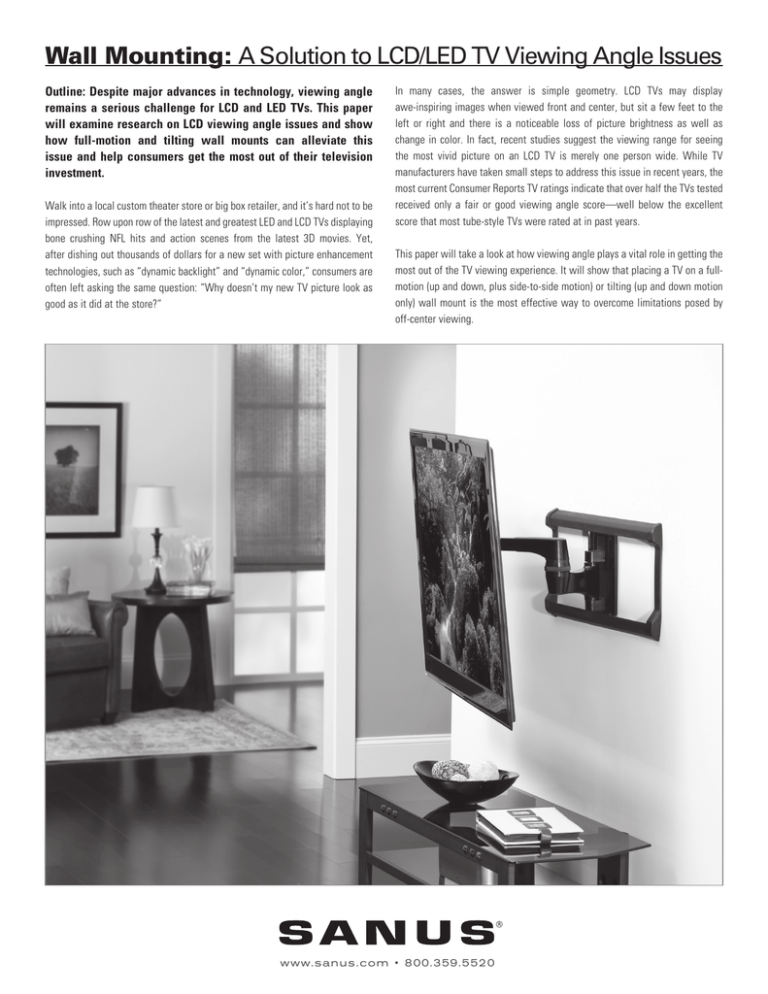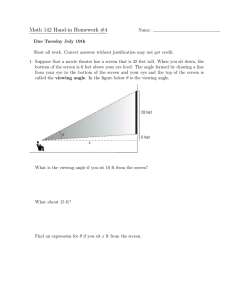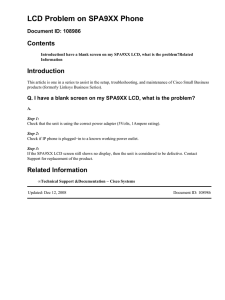
Wall Mounting: A Solution to LCD/LED TV Viewing Angle Issues
Outline: Despite major advances in technology, viewing angle
remains a serious challenge for LCD and LED TVs. This paper
will examine research on LCD viewing angle issues and show
how full-motion and tilting wall mounts can alleviate this
issue and help consumers get the most out of their television
investment.
Walk into a local custom theater store or big box retailer, and it’s hard not to be
impressed. Row upon row of the latest and greatest LED and LCD TVs displaying
bone crushing NFL hits and action scenes from the latest 3D movies. Yet,
after dishing out thousands of dollars for a new set with picture enhancement
technologies, such as “dynamic backlight” and “dynamic color,” consumers are
often left asking the same question: “Why doesn’t my new TV picture look as
good as it did at the store?”
In many cases, the answer is simple geometry. LCD TVs may display
awe-inspiring images when viewed front and center, but sit a few feet to the
left or right and there is a noticeable loss of picture brightness as well as
change in color. In fact, recent studies suggest the viewing range for seeing
the most vivid picture on an LCD TV is merely one person wide. While TV
manufacturers have taken small steps to address this issue in recent years, the
most current Consumer Reports TV ratings indicate that over half the TVs tested
received only a fair or good viewing angle score—well below the excellent
score that most tube-style TVs were rated at in past years.
This paper will take a look at how viewing angle plays a vital role in getting the
most out of the TV viewing experience. It will show that placing a TV on a fullmotion (up and down, plus side-to-side motion) or tilting (up and down motion
only) wall mount is the most effective way to overcome limitations posed by
off-center viewing.
www.s anus .com • 800.359.5520
Viewing Angle 101
Viewing angle is a TV specification that is often overlooked by consumers
during the buying process. In its simplest terms, viewing angle is defined
as the maximum angle at which a display can be viewed without losing
brightness or experiencing color shifts. Optimal or ideal viewing can be
defined as watching TV directly in front of the screen at eye level (0°
below). As soon as one moves off center, either vertically or horizontally,
TV picture quality begins to decrease – the screen looks dim and the color
is faded. Most manufacturers do not specify the angle at which noticeable
picture degradation occurs; rather, they only specify the angle at which the
picture is still visible.
Due to the nature of the technology, LCD TVs have more viewing
angle issues than plasma sets.
Nearly all LCD TV manufacturers claim a viewing angle of 88 degrees or more,
with 88 degrees being the greatest side angle in which a TV maintains clearly
defined images and accurate colors. According to the below illustration, one can
stand almost completely to the side of a TV and still experience high picture
quality. In most cases, by looking at an LCD TV once, one will realize the industry
standard of quality viewing angles is debatable. In fact, recent industry research
indicates there is noticeable picture quality degradation in as little as 10 degrees
from the optimal viewing angle, even with the most expensive LCD TVs.
90º
90º
80º
80º
70º
70º
60º
60º
50º
40º
50º
30º
20º
10º
0º 10º
20º 30º
40º
contrast ratio
Performance issues are most clearly depicted by contrast ratio numbers.
Contrast ratio is the ratio of the white image brightness to the black image
brightness. This ratio plays a vital role in a screen’s clarity and image detail.
Mathematically, contrast ratio is measured by the following equation:
Brightness at the screen center when
all pixels are “white” Contrast Ratio (CR) =
Brightness at the screen center when
all pixels are “black”
The higher the first number in the ratio, the brighter the screen and the greater
the contrast between black and white. For example, a contrast ratio of 2000
indicates the brightest white is 2000 times brighter than the darkest black on a
screen. Currently, no industry standard exists on calculating contrast ratio, so
the way each manufacturer calculates its numbers varies. For this reason, it is
important to only compare contrast ratio numbers from the same manufacturer.
field research
Measuring the contrast ratio values of four HDTVs (Panasonic Plasma,
Samsung LCD, Sharp LCD and Sony LCD) at 0 degrees and at a 45-degree
viewing angle, Soneira found the plasma TV contrast ratio was down 9 percent;
however, the 45-degree angle reduced the contrast ratio for all three LCD TVs
by over 50 percent. On some LCD TVs, noticeable picture degradation was
found at a viewing angle as low as 10 degrees. The findings below clearly
illustrate the dramatic loss of contrast ratio when viewing an LCD TV at a
45-degree viewing angle.
According to Soneira, the findings were surprising. “Everyone that came to
see the test, including industry experts, manufacturers, engineers, reviewers,
journalists and ISF instructors, were shocked at how strong the viewing angle
effect is,” said Soneira. “Everyone knew there were effects, but the side-byside comparison shows how incredibly large it actually is.”
Along with contrast ratio values, LCD TV color quality also proved to be
affected by viewing angle. All three LCD TVs that were tested showed
noticeable degradation in color accuracy at a viewing angle of just 15
degrees, and this accuracy decreased exponentially at 30 degrees off-axis.
0 Degrees
45 Degrees
Panasonic Plasma
3,842
3,502
Samsung LCD
1,877
462
Sharp LCD
1,330
174
Sony LCD
1,344
467
DisplayMate Technologies
“The significance of this is enormous,” explained Soneira, “because it
means the ‘sweet spot’ for seeing an accurate picture on an LCD TV is
about one person wide.”
Recently, in its annual consumer ratings, Consumer Reports added viewing
angle to its TV evaluation criteria, highlighting the importance of this element.
The publication explained: “Viewing angle remains a challenge for most LCD
displays. Some models have gotten better in this respect, but most still lag far
behind plasma and picture-tube TVs in providing a virtually unlimited viewing
angle.” In the most recent Consumer Reports TV ratings, no LCD TV earned an
“excellent” rating for viewing angle, and more than half of the tested LCD TVs
received only a fair or good viewing angle rating.
It is also important to note that viewing angle performance did not
discriminate based on price point. Some of the most expensive units
tested received a high rating in picture quality but fell short in the
viewing angle category.
Those who hope new 3D HDTV technology will fix viewing angle issues will be
disappointed. Despite delivering eye-popping images, 3D TVs also suffer from
viewing limitations. In fact, some argue that the 3D technology increases the
problem. Early 3D reviews indicate that “ghosting”, defined as light shadows
around objects on the screen, is apparent when viewing from an angle. In
May 2010, during its first 3D TV reviews, Consumer Reports noted picture
degradation when testers moved off-center. Furthermore, in his June 2010
review of the Samsung 46-inch 3D LED TV, Sound and Vision Magazine’s Al
Griffin claimed that “like other LED TVs the Samsung had a limited viewing
angle – its picture contrast and color accuracy took a hit when I shifted more
than 15° off from the center line in either direction”.
10
9
Visually Detectable Color Difference Threshold = 1
While LCD TV viewing angle limitations have been rumored in the technology
industry for some time, the most widely recognized research on this topic
was conducted in 2009 by Dr. Raymond Soneira, President of DisplayMate
Technologies. DisplayMate Technologies is a testing firm that produces video
calibration, evaluation and diagnostic products for the technology industry. In
his analysis titled “LCD-Plasma Display Technology Shoot-Out”, Soneira tested
the picture performances of the top 2008 lines of plasma and LCD TVs. He
found empirical evidence of LCD TVs’ inability to maintain picture quality when
viewed from an angle.
8
Samsung LCD
7
6
Sony LCD
5
Sharp LCD
4
3
2
Just Noticable Color Difference
1
Panasonic Plasma
0
0
15
30
Viewing Angle, Degrees
DisplayMate Technologies
45
Mounting Solution
So, the question remains: How can one enjoy top-notch picture quality and
90º
bargain prices that many LCD TVs currently offer without falling victim to viewing
angle issues? Nearly all experts agree that full-motion80º
TV wall mounts are the
ideal solution with their ability to tilt, swivel and extend in every direction. By
70º that the optimal
placing an LCD TV on a full-motion mount, one can be certain
viewing angle is always available, whether watching TV from a favorite chair
60º
directly in front of the TV or from a couch in the corner of a room.
50º
With the ability to tilt TVs up and down, tilting mounts are also 40º
a great solution
20º
to obtaining the optimal viewing angle. Tilting mounts ensure high30º
picture
quality when watching an LCD TV while lying on a bed or viewing a TV that is not
mounted at eye level. Tilting mounts also highlight the thin look of many popular
LED TVs on the market by placing them extremely close to the wall.
90º
80º
70º
60º
50º
10º
0º 10º
20º 30º
40º
Both full-motion and tilting mounts not only improve viewing angle – they also
help reduce glare on TV screens in rooms with many lights or windows. The
ability to adjust a TV up and down or side-to-side can eliminate unwanted
reflections on a TV screen.
SANUS® engineers and manufactures full-motion and tilting wall mounts
that fit all sizes of LCD TVs. With full-motion mounts that extend as far as
28 inches from the wall, a SANUS mount helps ensure the proper viewing
angle is available anywhere in a room. Adding to their mounts’ convenience
and versatility, SANUS mounts also offer exclusive technologies, such as
Virtual Axis™ technology that allows effortless tilt motion with the touch of
a finger and ClickStand™ mechanism that props TVs away from the wall for easy
cable access.
With all the advantages that LCD TVs offer, such as choice among brands
and performance in bright rooms, one should never be limited by viewing
angle issues. To take full advantage of today’s TV technologies, purchase
a full-motion or tilting wall mount.
References
Consumer Reports
• “Best Electronics: LCD&Plasma TVs.” Consumer Reports, December 2008. 28 – 33.
• “Best Electronics: LCD&Plasma TVs.” Consumer Reports, December 2009, 23 – 28.
• “Best TVs for the buck.” Consumer Reports, March 2010, 22 – 25.
• “Viewing angle still the Achilles heel for most LCD TVs.” Consumer Reports, July 17, 2009.
• “Why viewing angle matters with LCD TVs.” Consumer Reports, November 2009.
DisplayMate Technologies
• Soneira, Raymond, “LCD-Plasma Display Technology Shoot-Out.” Displaymate.com, 2009.
New York Times
• Taub, Eric, “So Many Flat-Panel TVs, Which is Right for You?” New York Times, June 17, 2009.
• Taub, Eric, “TV Specs: Can they be trusted?” New York Times, June 30, 2009.
Sound and Vision Magazine
• Griffin, Al, “The Real Slim Shady.” Sound and Vision Magazine, February/March 2010, 53 – 55.
• Griffin, Al, “Break on Through.” Sound and Vision Magazine, June/July/August 2010, 45 – 47.
Widescreen Review
• Soneira, Raymond, “LCD-Plasma Display Technology Shoot-Out.” Widescreen Review,
August 2009, 24-29.
ZDNet
• Portnoy, Sean, “Study: LCD viewing angles are too narrow, many TV features are marketing fluff.” ZDNet, July 7, 2009.
www.s anus .com • 800.359.5520
©2010 Milestone AV Technologies, a Duchossois Group Company.All rights reserved. Sanus is a division of Milestone.
Mounting a TV has many other benefits as well. It can make valuable space
in a room by removing the need for furniture, creating a clean and sleek
appearance. With the number of injuries and deaths resulting from unstable
flat-panel TVs growing at an alarming rate, mounting a TV also adds to the safety
of a room by helping to prevent accidental bumping or tipping.




